DayLily: Grow & Care for Hemerocallis Fulva
Written by Iris
Oct 13 2021
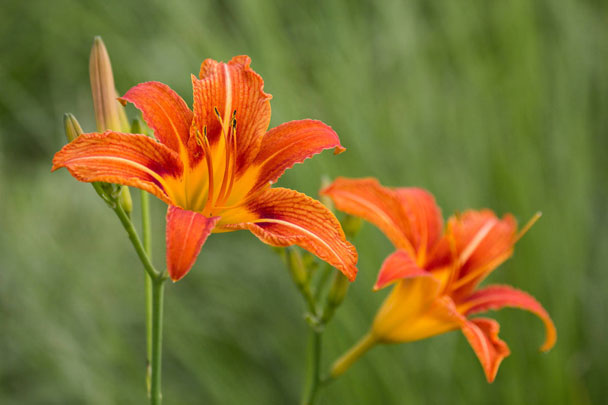
DayLily (Hemerocallis Fulva) in flower meanings are very abundant, one of which is the forgetting of love, which means forgetting the previous emotions and emotions. There is also a flower language that hides the mood, meaning that it is not easy to express one's emotions. The alias of Hemerocallis is also called forget melancholy. DayLily Flower language is to let go of sorrow, meaning to forget the unhappy and unhappy things before. Hemerocallis also symbolizes great maternal love.
Don't plant near trees and shrubs that will compete for moisture and nutrients.
To increase organic matter, add aged manure or compost to the soil before planting.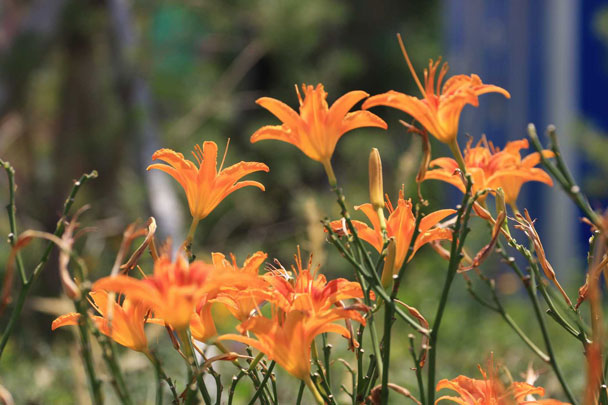
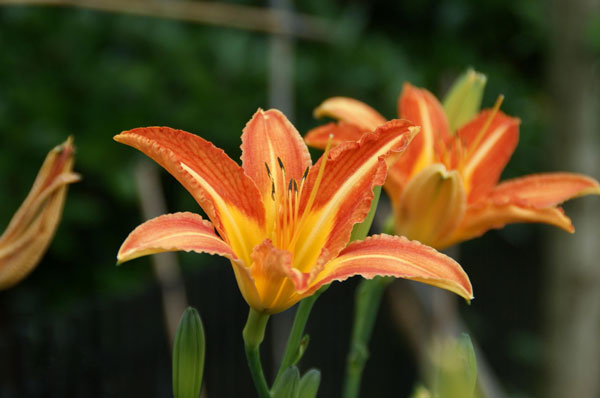
Dig up individual clumps and put them on a tarp. Use a sharp knife or spade to separate healthy young plants (fans) with strong root systems. Cut back the foliage and replant immediately in compost-amended soil or plant in containers for holding. You'll have many extra plants from each clump to give away to friends and neighbors. Discard any small or diseased plants.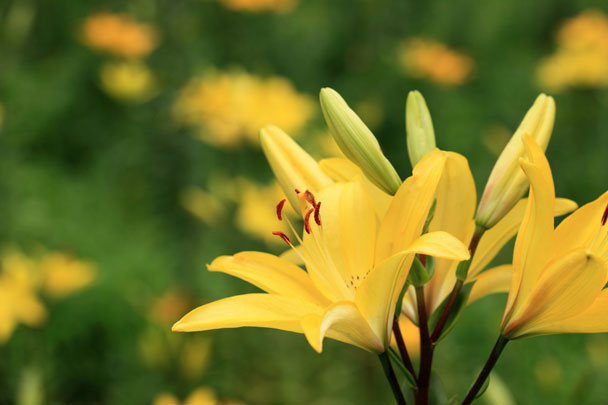
Although daylilies are drought tolerant they will bloom better if they receive water regularly. Here at Amador Flower Farm, we water all of our gardens using overhead sprinklers. Our demonstration gardens are watered daily and our growing grounds are watered twice a week during our very hot and dry California summers. Our gardens all have 3″ to 4″ of mulch. We feel this makes our beds look nicer. Using mulch also prevents moisture from evaporating rapidly and helps to control weed growth. We use a partially rotted bark to mulch our beds.
As winter approaches, it is best to leave the foliage in place, allowing it to die off and cover over the plant. This will help with insulation and act as a protective layer throughout the winter.
In the cooler spring weather check your daylilies for signs of aphids around the young buds. If caught early, spraying with insecticidal soap is often an effective remedy.
Also, check for telltale nighttime damage at the base of the leaves from slugs and snails and be sure to remove any leaf litter and other hiding places from around the plants.
Infrequently, spider mites or thrips may be found on the plants during hot weather. If the infestation is caught early, an application of insecticidal soap can be an effective remedy.
Maintaining good air circulation among your plants will help avoid fungal infections. However, if plants are attacked by fungal diseases you will notice unsightly yellow or orange streaks along the length of the strap-like leaves.
If you see this, remove the damaged leaves and dispose of them separately. Do not add them to your compost pile as the spores may winter over and can restart the disease cycle.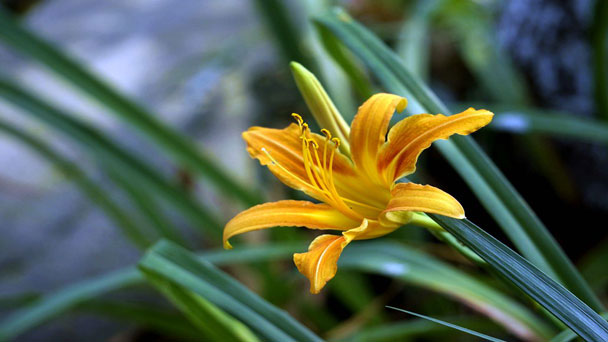
Some of our favorite cultivars include:
‘Stella de Oro’
has numerous yellow flowers per scape and blooms all summer.
‘Little Grapette’
has small purple flowers and blooms early summer. This daylily is only 12 inches tall.
‘So Sweet’
has yellow flowers. Its leaves remain green over winter.
‘Ruby Spider’
has large, up to 9-inches wide, scarlet-red flowers with golden throats.
‘Catherine Woodbury’ blooms in mid- to late-summer with fragrant lavender-pink flowers.
‘Indian Giver’
has large rich-purple flowers and blooms early to late summer. It's semi-evergreen.
‘Siloam Double Classic’
has fragrant, salmon-pink, double blossoms in early to mid-summer. It's ideal for containers.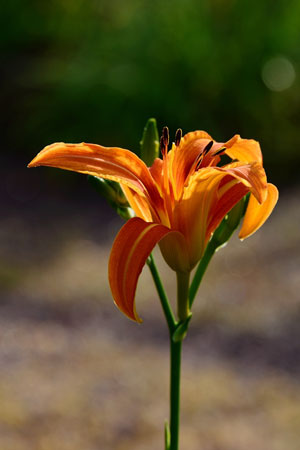
Individual blooms only last for a day, but multiple flowers on each stem bloom in succession, extending the overall bloom time for a single plant to about a month.
Some varieties rebloom, such as Rainbow Rhythm® 'Going Bananas', flowering several times throughout the season until fall. Rebloomers generally perform best in mild southern climates.
Where to Grow DaylilyWhen to Grow DayLily (Hemerocallis Fulva)How to Grow DayLily (Hemerocallis Fulva)DayLily Propagation with BulbsDayLily Propagation with DivisionHow to Care for DayLily (Hemerocallis Fulva)DayLily LightingDayLily Soil CareDayLily WateringDayLily Temperature & Humidity CareDayLily FertilizerDayLily PruningDayLily Pests & Diseases CareVarieties of DayLily (Hemerocallis Fulva)When do daylilies bloom?
Where to Grow Daylily
Although daylilies will survive in less-than-ideal conditions, they will perform best if given full sun and a spot with well-drained, fertile soil.Don't plant near trees and shrubs that will compete for moisture and nutrients.
To increase organic matter, add aged manure or compost to the soil before planting.

When to Grow DayLily (Hemerocallis Fulva)
Plant daylilies in the late spring or early fall for best results. However, if you find a plant that you simply must have during a summer sale, bring it home and plant it immediately. Just keep an eye on it and water frequently during the first few weeks.
How to Grow DayLily (Hemerocallis Fulva)
DayLily Propagation with Bulbs
- Choose a spot in the garden that receives full sun and has well drained soil.
- Enrich the soil with some compost and Yates Dynamic Lifter Soil Improver & Plant Fertiliser well before planting.
- Place the bulb directly where the plant is to grow at a depth of 10cm and 30cm apart.
- Cover with soil.
- Keep the soil nice and moist ensuring not to overwater.
- Towards the end of winter, when the shoots begin to emerge feed every 1 to 2 weeks with Yates Thrive Roses and Flowers Liquid Plant Food.
DayLily Propagation with Division
One of the few routine maintenance chores needed when growing daylilies is dividing them. Depending on their growth, your daylily clump will usually become crowded after four to five years and flowering will diminish. In most areas, late summer is the best time to divide daylilies. In the North, early spring is an alternate option, especially if the weather typically turns cold quickly in fall.Dig up individual clumps and put them on a tarp. Use a sharp knife or spade to separate healthy young plants (fans) with strong root systems. Cut back the foliage and replant immediately in compost-amended soil or plant in containers for holding. You'll have many extra plants from each clump to give away to friends and neighbors. Discard any small or diseased plants.

How to Care for DayLily (Hemerocallis Fulva)
DayLily Lighting
This perennial thrives in full sun. Ensure that it receives six or more hours of sun each day. In very hot climates, provide some afternoon shade, knowing that the plant will likely produce fewer flowers.DayLily Soil Care
Daylilies adapt to a wide range of soils from light sand to heavy clay. Still, they prefer deep fertile loamy soil. If your soil is sandy, that means it will likely dry out easily. Add some compost to encourage moderate moisture retention. If your soil has a lot of clay, mix in some compost, peat or leaf mold, all of which provide nutrients and acids for the daylily's preferred slightly acidic soil pH.DayLily Watering
They will perform best with consistent watering—about 1 inch per day. It is important to water plants regularly in spring when scapes and buds are forming and also while blooming.DayLily Temperature & Humidity Care
The hardy daylily can be grown from USDA zone 3 to zone 9, so they can tolerate both summer heat and humidity, as well as returning each year after cold winters.DayLily Fertilizer
An organic compost soil is seldom deficient in plant nutrients. To maintain excellent daylily growth on a midseason beauty like Amador’s South Street, above, add any slow release, composted organic matter such as horse, sheep or cow manure, or your own compost, in either spring or fall.Although daylilies are drought tolerant they will bloom better if they receive water regularly. Here at Amador Flower Farm, we water all of our gardens using overhead sprinklers. Our demonstration gardens are watered daily and our growing grounds are watered twice a week during our very hot and dry California summers. Our gardens all have 3″ to 4″ of mulch. We feel this makes our beds look nicer. Using mulch also prevents moisture from evaporating rapidly and helps to control weed growth. We use a partially rotted bark to mulch our beds.
DayLily Pruning
To keep your orange daylily vibrant and healthy, some minor deadheading may be needed. If all of the flowers on a flower stalk have bloomed, you can cut the whole stalk down to the ground to keep a tidy look. Feel free to remove any unsightly foliage or seed pods as well.As winter approaches, it is best to leave the foliage in place, allowing it to die off and cover over the plant. This will help with insulation and act as a protective layer throughout the winter.
DayLily Pests & Diseases Care
Daylilies are generally carefree plants that, once established, will thrive for many years in your garden. Good sanitation, especially removing leaf litter from around the crown of the plant will go a long way towards keeping your daylily collection free of pests.In the cooler spring weather check your daylilies for signs of aphids around the young buds. If caught early, spraying with insecticidal soap is often an effective remedy.
Also, check for telltale nighttime damage at the base of the leaves from slugs and snails and be sure to remove any leaf litter and other hiding places from around the plants.
Infrequently, spider mites or thrips may be found on the plants during hot weather. If the infestation is caught early, an application of insecticidal soap can be an effective remedy.
Maintaining good air circulation among your plants will help avoid fungal infections. However, if plants are attacked by fungal diseases you will notice unsightly yellow or orange streaks along the length of the strap-like leaves.
If you see this, remove the damaged leaves and dispose of them separately. Do not add them to your compost pile as the spores may winter over and can restart the disease cycle.

Varieties of DayLily (Hemerocallis Fulva)
There are thousands of beautiful daylilies to choose from! Combine early, mid-season, late blossoming varieties, and repeat bloomers to have daylilies in flower from late spring into fall. Daylily flowers may be fragrant and come in many colors, shades, and color combinations. Some flowers are full and round, others have wide petals with ruffled edges. Daylilies called “spiders” are spider-like in shape, while “doubles” have double the number of petals and sepals. Some new cultivars are even night-blooming and very fragrant.Some of our favorite cultivars include:
‘Stella de Oro’
has numerous yellow flowers per scape and blooms all summer.
‘Little Grapette’
has small purple flowers and blooms early summer. This daylily is only 12 inches tall.
‘So Sweet’
has yellow flowers. Its leaves remain green over winter.
‘Ruby Spider’
has large, up to 9-inches wide, scarlet-red flowers with golden throats.
‘Catherine Woodbury’ blooms in mid- to late-summer with fragrant lavender-pink flowers.
‘Indian Giver’
has large rich-purple flowers and blooms early to late summer. It's semi-evergreen.
‘Siloam Double Classic’
has fragrant, salmon-pink, double blossoms in early to mid-summer. It's ideal for containers.

When do daylilies bloom?
Depending on the type, plants may begin blooming mid-spring, and some continue until fall. In milder regions, they will begin blooming a few weeks earlier than in colder areas.Individual blooms only last for a day, but multiple flowers on each stem bloom in succession, extending the overall bloom time for a single plant to about a month.
Some varieties rebloom, such as Rainbow Rhythm® 'Going Bananas', flowering several times throughout the season until fall. Rebloomers generally perform best in mild southern climates.
Latest Updated
- Benefits of Bugleweed - 7 Science-backed Health Benefits
- Bugleweed Dangers & Side Effects - Is It Poisonous?
- How to Plant Evergreen Trees - What You Should Know
- When to Plant Evergreens - Grow Guide for Evergreen Trees
- 12 Wonderful Evergreen Shrubs for Your Garden
- 12 Popular Evergreen Plants with Pictures for Beginners
- When And How To Prune A Lilac Bush Like a Pro
- How to Grow & Care for Lilac Vine (Hardenbergia Violacea)
- Japanese Lilac Tree (Syringa Reticulata) Care & Propagation Guide
- Shumard Oak Pros and Cons - What to Know
Popular Articles
- Winter maintenance of Antirrhinum Majus
- How to Grow Terminalia Mantaly Tree
- How to Grow and Care for Crossostephium Chinense
- How to grow Antirrhinum Majus in spring
- Peristeria Elata (Dove Orchid) Profile: Info & Care Guide
- Underwatered Snake Plant (Sansevieria Trifasciata) - Signs And How To Fix
- How to Care for Brazilian Jasmine Plant (Mandevilla Sanderi)
- How to Grow & Care for Graptopetalum Purple Delight in Summer
- Rosa Chinensis (China Rose): Plant Growing & Care Tips
- How to Care for Baby Sun Rose (Aptenia Cordifolia)